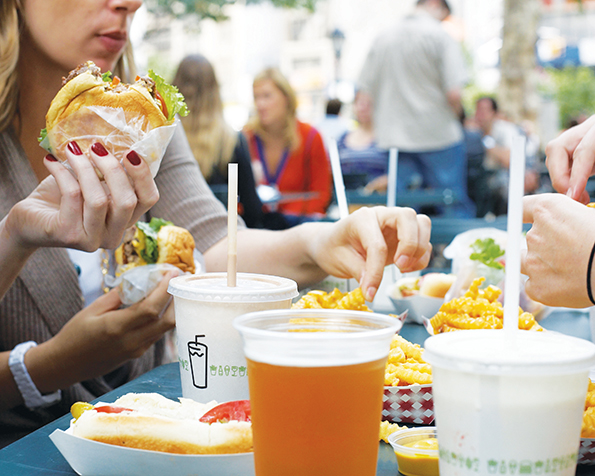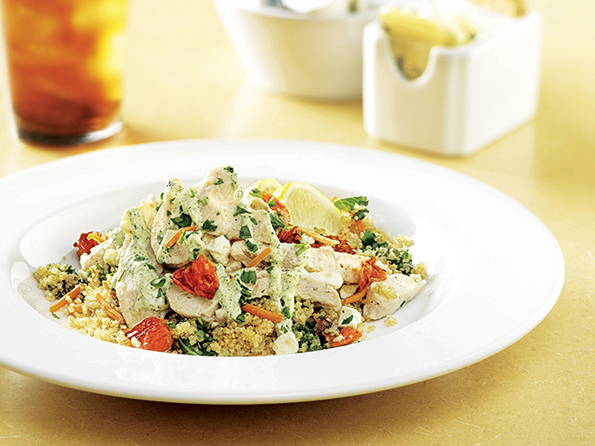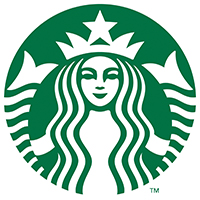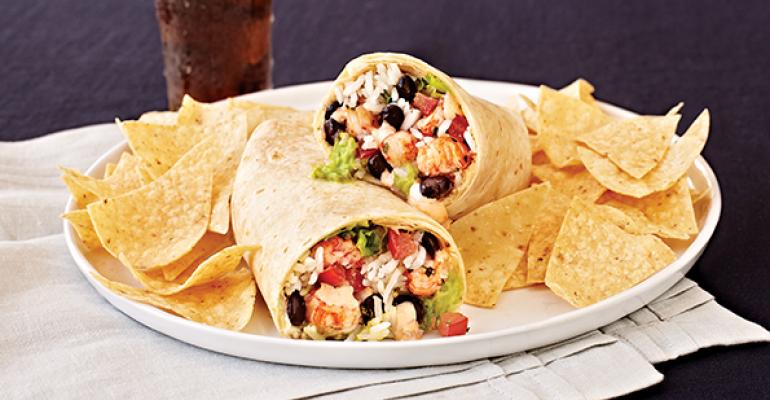The contrasting tales of McDonald’s and Chipotle in 2014 — one a very bad year (McDonald’s) and one a standout performance (Chipotle) — sparked somewhat of an existential crisis throughout the industry.
Pundits on food and foodservice saw the contrasting results as a reflection of a seismic change in consumer demand. Traditional ways of fast food were clearly falling by the wayside — at the expense of McDonald’s, they argued. While newer, fresher ways of preparing food fast have caught consumers’ desires — especially those of Millennials, many claimed.
Times are changing. And while restaurant brands have always strived to change with the times, this shift is different.
“No change whatsoever has floored me more than the one we’re going through right now, which is something I never thought I’d see in my lifetime,” Danny Meyer, CEO of Shake Shack and the Union Square Hospitality Group, said in a speech last month for TEDxManhattan, “and that is the convergence of fine dining and casual dining. They’re getting married.”

Where fine-dining restaurateurs once ran from the notion of being considered a chain, now they have begun to embrace the concept that restaurants can be replicated and still maintain quality, he said.
At the same time, chains have come to take on fine-dining principles of hospitality and thoughtfulness about food, supply chain and employees in ways still compatible with stripped-down service formats and efficient systems.
The result has been a flourishing of concepts that mostly fall into growing restaurant segments like fast casual, chef casual or fast-casual-plus. Brands like Tender Greens, LYFE Kitchen, Sweetgreen and Shake Shack, are among many that fit into those categories.
At the same time, a growing number of quick-service players, including McDonald’s, are working to retrofit their concepts to produce better food with the same level of convenience and affordability.
Customer first and always
It’s all about maintaining relevancy with the changing tastes of consumers, said Michael Donahue, a former McDonald’s executive who co-founded the 15-unit LYFE Kitchen and serves as its chief branding officer.
“The whole thing started with the consumer,” he said. “For them, it’s not just does your food taste good. It’s about whether the restaurant operates with good taste.”
What that means is a matter of debate, he said.
“It’s never about one thing. It’s multidimensional,” he said.
As this sea change progresses, existing chains are striving to identify what resonates most with consumers. Is it customization or social branding with a cause? Is it about engaging Millennials or serving local produce? Is it about mobile ordering and payment, or Sriracha?

This year’s fifth annual Consumer Picks survey from Nation’s Restaurant News and WD Partners offers some clues about what’s working.
Consumers were asked to rank restaurant chains they had recently visited on 10 attributes. (See all ranked attributes and the survey methodology on page 85). Of those, one attribute was ranked most important for almost all surveyed, even when broken down by gender, age, marital status or household income: Food Quality.
Consumers today are looking very closely at the food on chain restaurant menus and expecting better, said Dennis Lombardi, executive vice president, foodservice strategies at WD Partners, the Dublin, Ohio-based consulting firm that oversees the Consumer Picks survey.
Baby boomers look for food quality somewhat more than Millennials — though both age groups said quality was most important. That was also true for high school graduates and college grads, as well as those earning less than $50,000 and those earning more than $100,000.
Looking at the top performers across 20 industry segments — from burgers to fine dining — 14 of the top brands this year also had the respective segment’s top marks for the survey attribute of Food Quality.
Newcomer to the survey, First Watch, for example, scored significantly higher on food quality among family-dining players, with a rating of 79.9 out of 100. Cracker Barrel Old Country Store came in a distant second with a 70.9 ranking for Food Quality.
First Watch, a 120-unit chain based in Bradenton, Fla., is known for healthful menu items like the Quinoa Power Bowl that won the 2014 Nation’s Restaurant News MenuMasters award for Healthful Innovation. But also known for more indulgent made-from-scratch offerings, like French Toast Monte Cristo, with house-made sourdough French toast filled with ham, turkey, Swiss and Dijionaise, grilled and dusted with powdered sugar.
Perennial limited-service winner In-N-Out Burger scored an 84.6 for Food Quality, tipping the scales into fine-dining-type rankings.
Unlike most large burger chains, In-N-Out, which was founded in 1948, never took on some modern quick-service practices like using frozen fries or pre-processed meat. The Irvine, Calif.-based chain, now with 303 units, has limited its growth to ensure units can be served never-frozen meat daily by processing plants owned by the company, where in-house butchers cut and grind beef for patties that meet the chain’s high standards. Fries are made from real potatoes, cut in full view of customers.
Among Mexican chains, Rubio’s edged out Chipotle for the lead, scoring even higher on Food Quality, and most other attributes, though consumers ranked Chipotle highest for Reputation.
Rubio’s, a 193-unit chain based in Carlsbad, Calif., has long been known for fish tacos — something Chipotle doesn’t offer. Rubio’s is leveraging that strength by changing its name to Rubio’s Coastal Grill while rolling out a broader grilled seafood menu as part of a brand revamp.
An upgrade of food may raise prices, but it can still be a value play, said Ralph Rubio, the chain’s founder.
“You can get an amazing grilled shrimp burrito for around $8,” he said. “There’s a huge value opportunity here.”
Food quality is more than taste
While the quality of food tops customers’ biggest need from a restaurant, what “quality” actually means can be different things to different people. Finding that definition for a restaurant brand and its customers is at the crux of the industry’s seismic shift in recent years.
Some see quality in food clean of “Big Agriculture” practices, such as the use of growth hormones, antibiotics and pesticides.
Chipotle has built a reputation around its brand purpose of serving “Food with Integrity,” and focusing its menu on meat raised without antibiotics or growth hormones, organic and locally raised produce and dishes made from scratch.
McDonald’s, meanwhile is struggling mightily to shake off its consumer reputation as the junk food leader.
“The McDonald’s name, for the first time in history, may be a detriment,” said Donahue, who was the Oak Brook, Ill.-based chain’s chief communications officer for 19 years until 2006.
This year McDonald’s rolled out a food transparency campaign answering consumer questions like, “Why doesn’t your food rot?” and “Do you even sell real food?”
McDonald’s also joined a growing number of brands pledging to serve chicken raised without the use of human antibiotics and growth hormones, something Chipotle did years ago. Other brands working toward that same promise include Chick-fil-A, Panera Bread and Noodles & Company.
In addition, 1,150-unit Carl’s Jr. this year added an “All Natural” grass-fed, free-range burger, using meat sourced from Australia and raised without antibiotics, steroids or added hormones.
Outside of how the food is made or prepared, the notion of “freshness” is also a key aspect of food quality, the Consumer Picks survey indicated.
Canada-based Sarku Japan, for example, a quick-service Asian concept often found in malls, nearly swept the Asian noodle category, beating fast-casual Noodles & Company, which was last year’s winner.
Known for teriyaki, sushi and bento boxes, the more-than 200 unit Sarku chain conveys freshness through its open-kitchen format.
“Sarku offers theater of cooking,” Lombardi said. “That all says ‘fresh’ to the consumer, especially when they start throwing a bunch of vegetables on the grill.”
Increasingly, consumers are embracing what has become known as “real food,” dishes made from scratch, from unprocessed ingredients.
For young emerging brands like the Top Round Roast Beef restaurant in Los Angeles, a better-roast-beef sandwich concept founded by former fine-dining chef Anthony Carron, the promise of real food is a point of differentiation.
Top Round offers “good old-fashioned fast food, before machines and mystery meats got into the mix,” the website says.
The concept is based on whole-roasted top-round beef slow-roasted over 12 hours to produce the tender meat for sandwiches. Fries are cooked in the resulting beef tallow. Everything is made in house.
Carron said that’s fundamentally what consumers want.
“People want fast food, but they want to put something better into their bodies. They don’t want to eat processed, artificial stuff,” he said. “There’s a way to do that in fast food. You do a lot of volume, keep your menu simple to keep food costs down, and put it out fast.”
Bringing upscale downtown
High-quality food, simple menu and speed of service, that’s the model used by Shake Shack, Meyer’s 63-unit better-burger brand, which went public this year. The offering garnered $105 million and put the chain’s value at nearly $1.8 billion on opening day.
A contemporary re-envisioning of fast food, Shake Shack uses only all natural, vegetarian-fed, humanely raised meat without hormones or antibiotics. “We pride ourselves on sourcing incredible ingredients from like-minded artisanal producers,” the chain’s website boasts.
“We are now at the precipice of a whole new movement that is fine casual.” Meyer said in his TEDxManhattan talk.
Meyer credits brands like Starbucks, Whole Foods and Chipotle with being the first chains to embrace fine-dining principles. Those qualities, Meyer said, include “caring about the people who worked there; caring about and restoring people who ate there; caring about the communities in which they did business; caring deeply about their supply chain, and, yes, making more money for their investors as a result.”
He also credited high-end French chef Joël Robuchon and his more-approachable, counter-style L’Atelier concept, and later David Chang of Momofuku and other concepts, with inspiring fine diners to go casual.
“David said, ‘What if I could take my favorite ethnic cooking, which was Asian, and strip away all the refinements of a traditional restaurant’,” Meyer said. “’I’m not going to give you backs on the chairs, but I’m going to make sure what’s in your bowl is really good.’”
 Scaling next-gen food brands
Scaling next-gen food brands
It remains to be seen whether the movement toward fine casual, fast casual, chef casual or even fast-casual-plus will produce a brand with the global scale of a McDonald’s, which tallies more than 36,000 restaurants in more than 100 countries.
Starbucks has come closest, with nearly 22,000 units in 66 countries, including about 14,000 in the U.S. With a coffee-centric concept, however, that’s not exactly an apples-to-apples comparison. Chipotle ended fiscal 2014 with just 1,783 units, including 17 outside the U.S., and nine locations of its secondary brand ShopHouse Southeast Asian Kitchen.
Even at that size, Chipotle has already struggled to source ingredients that meet the brand’s high standards of “Food with Integrity.” In 2014, some restaurants were forced to go without pork after a supplier was found in noncompliance after a routine audit. The bigger that chains like Chipotle get, the more pressure there will be on supply.
Size is also a factor in consumer preferences, the Consumer Picks survey found.
Brands like McDonald’s, Burger King and Krystal traditionally score at or near the bottom of such rankings, in part because they’re just too big and too pervasive.
Consumers love to bash the bigger chains, Lombardi said. Most specifically, such chains lose points on attributes like “most likely to recommend.”
“No one’s going to recommend something that’s ubiquitous,” Lombardi said.
Contact Lisa Jennings at [email protected].
Follow her on Twitter: @livetodineout

